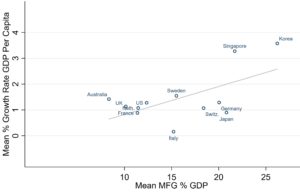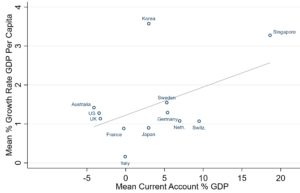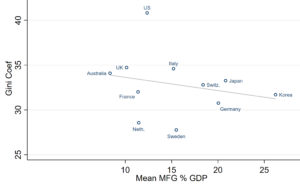Long-term economic growth is the single most important objective for any nation. As growth economist and Nobel laureate Paul Romer has said: “For a nation, the choices that determine whether income doubles in one generation or two dwarf all other economic policy concerns.”
In the United States, real income per capita grew in the 3%-4% range for much of the post-World War II period, from 1945-1973. In the years since 2000 it has grown at an average rate of 1.18%. This growth slowdown is one of the most important facts of U.S. economic life. It means there is less income to go around and since the upper income segment of the population has been taking a growing share of the total, less is left for middle-income and lower-income groups.
The Twin Secrets to Raising Long Term Growth Rates
Looking at the performance of the world’s leading economies over the last half-century, the evidence suggests that two important indicators provide the best explanation of the secrets of economic growth. Those indicators are the share of a nation’s gross domestic product (GDP) devoted to manufacturing, and the level of the current account balance as a share of GDP.
Manufacturing is a key contributor to growth because it is the only sector that can create multi-decade broad-based increases in labor productivity, which is the key to rising wages.
The current account balance is critical because a positive current account indicates that a nation is seizing a growing share of domestic and world markets in its growth industries. A large economy can achieve strong economic growth within its own market, and an economy that is funding its growth with external borrowing may show no current account surplus or even a small deficit. But the opposite is always true: a nation with a significant current account deficit is always in trouble because it is losing share in either foreign markets or its home market or both.
Short-term stimulus programs, such as adjusting interest rates or government deficits, can address a short-term recession but the evidence shows they have little impact on the long-term growth rate.
The History of U.S. Growth
In the century from 1870 to 1970, the U.S. enjoyed the most spectacular century of economic growth in its history, and perhaps of any nation in history. In the period since 1970, U.S. economic growth has been much lower. There was a brief upsurge in growth in the late 1990s, but after 2000 growth continued to be anemic.
When slow growth in GDP per person is combined with the persistent trend of rising income for the top 20%, 1%, and 0.1%, the inevitable result is stagnant or even declining living standards for many of the half of the U.S. population below the middle. According to data from Pew Research Center, between 2000 and 2018, the median household income of an upper income household rose by 7.9% to $207,400.
The median income of a middle income household rose by just 6.0% to $86,600 in these 18 years, while lower income households saw just a 1.8% rise to $28,700 a year. According to the Pew study, back in 1970, the U.S. was a society where middle income households accounted for the majority, in fact 62%, of all income. By 2018, middle income households’ share of income had fallen to 43%. They were overtaken by upper income households, with 48% of all household income.
The Singapore Example
Figure 1 charts the average annual growth of most of the world’s rich economies against the share of manufacturing in their GDP for the years from 2000 to 2019. (All figures come from the World Bank database.) The two nations that immediately stand out are South Korea and Singapore. In my view, Singapore is the most outstanding—literally, amazing—success story of the last half century. In 1975, the average income per head for Singapore’s five million people was $9,674, 61% below the U.S. figure of $25,120 (figures in 2010 US dollars).
Back then, Singapore was just another poor Asian nation struggling with post-colonialism, trying to find a role in the world after the British Navy abandoned its huge port and military base there. Yet by 2019, Singapore’s income per head was $59,374, 6% above the U.S. figure of $55,886. Crazy rich Asians indeed. In the 19 years from 2000 to 2019, Singapore delivered an annual growth rate of 2.96%, very similar to the rate the U.S. delivered in the Great American Century (1870-1970), but two and a half times higher than the rate the U.S. has been able to deliver in the 21st century. Bear in mind that Singapore has almost no natural resources, whereas the U.S. is endowed with many natural and man-made resources, including our amber waves of grain, our mineral resources, huge military, great universities, and so on.

Figure 1. Selected nations per capita real economic growth plotted against the average share of manufacturing in their GDP, 2000-2019. Source: World Bank, CPA calculations.
In the 35 years between Singapore’s independence and the year 2000, the island nation delivered an even more impressive annual per capita real GDP growth rate of 6.2%. How did Singapore do it? Singapore’s founding prime minister Lee Kuan Yew inherited a nation with a hostile, Communist-dominated labor union movement and simmering racial tensions between the Malay and Chinese population. He calculated that the only way he could hold his fractious nation together would be to kick-start a manufacturing boom which would generate the good-paying jobs that could lift living standards and entice the population to abandon its divisive class and racial politics.
Singapore’s economic policy was government-led. Singapore hired the best graduates out of its universities into its civil service. charged them with identifying the best growth industries and luring the most successful multinational corporations to open manufacturing plants in Singapore. (Yew, 2000) Today Singapore gets almost double the share of GDP from manufacturing as the U.S., 19.5% compared to 10.9%. Singapore’s largest manufacturing industries are in high-value-added, high-productivity sectors like electronics, chemicals, medical devices, and biotech. Singapore also benefits from keeping taxes low, and keeping the government out of most businesses. But a firm, decisive government leads and manages economic policy. It is always looking for the next growth industry.
Why is Manufacturing Key to Solid Growth?
There are two features that make manufacturing uniquely powerful for economic growth. The first is leverage. If a successful product is developed, it can often achieve huge growth rates in sales. The economies of scale in manufacturing and the presence of few competitors in new product areas mean that revenue, production, and profit can grow rapidly. Profit is what generates the funds for investment, and investment is what generates the rise in productivity that raises wages. If a nation has enough growth industries, that translates into a rapid growth in GDP.
The U.S. automobile industry is the best illustration of this phenomenon. When the first Model T rolled off Henry Ford’s production line in 1908, the U.S. economic miracle moved into a higher gear. Over the next two decades, the price of a Model T fell by more than 70%, Henry Ford became one of the richest men in the world, billions of dollars were invested in car production, workers’ wages rose dramatically, and dozens of related new industries were spawned. When a reporter in the late 1920s asked an Indiana farmer why his family had a car but no bathtub, his wife replied: “You can’t go to town in a bathtub.”
The second feature is equally important but less well understood. Growth industries pay workers more. Economic literature has documented this phenomenon for over a century and across multiple nations. (Krueger & Summers, 1986) When companies are growing rapidly, their profit tends to be higher and they need to pay whatever it takes to attract workers. Manufacturing industries are a vehicle for a more equal distribution of income. This is not only good for equity. It’s also good for reinforcing the growth trend. One reason the U.S. enjoyed rapid growth in the century up to 1970 is that workers in the growth sectors, led by the automotive sector, spent their income on more U.S.-made goods, creating a multiplier effect.
The German Example
An interesting comparison is between the UK and Germany. In the pre-World War II period, British incomes were some 25% higher than those in Germany. The aerial bombing of World War II devastated industry in both countries but the damage was far worse in Germany. By 1950, both countries were aggressively rebuilding. But Germany had a larger heavy manufacturing industry and grew faster. In the 1950s, German GDP grew at nearly 8% a year, the fastest growth rate in Europe (Eichengreen and Ritschl, 2008).
Britain meanwhile, deemphasized heavy manufacturing as sectors like shipbuilding, steel and coal struggled with foreign competition and dysfunctional labor-management relations. In the 1960s Germany surpassed Britain in output per head. Today it is 9% above Britain. Germany’s manufacturing sector is twice the size of Britain’s (17.8% vs. 8.4%) and its growth rate is significantly higher. Successful, broadly-based growth is a large part of the explanation for why German voters are generally at peace with their government, the European Union, and life in general, while British voters are more polarized and dissatisfied.
Why Does the Current Account/Trade Balance Matter?
For some countries, a strong government leader can create the conditions for economic growth. Singapore with Lee Kuan Yew and South Korea with President Park Chung Hee directed their business community to invest in the heavy manufacturing industries they determined their countries needed. For everybody else, there is the current account balance.
The current account includes three main components: the trade balance (exports of goods and services minus imports), income from U.S. companies’ foreign divisions (called primary income) and income or outgoings from remittances and similar transfers (known as secondary income). In the U.S. as in most countries, the trade balance dominates. Last year, our current account deficit was $616 billion while our trade deficit was $676 billion. A positive current account balance is highly beneficial to a nation in several ways. First, it creates a stimulus for demand because it adds foreign market opportunity on top of the domestic market opportunity. More production only works if somebody buys the product. Exports are a source of customers and sales. Imports reduce home demand for domestic production. Exports good. Imports bad. Simple. It is one of those concepts that is too simple for economists to grasp but most other people have no trouble with it.
The second reason the trade balance is important is that it keeps industry honest. Inside a single country, a small number of companies can lock up the market and put the brakes on innovation, but the global market usually will not allow that. Small countries like Switzerland and Sweden have been successful in industry by being the best in the world in their chosen industry sectors. Foreign customers don’t cut them any slack so they need to stay at the top of their game, always innovating and always improving their product. In a domestically focused economy, a small number of companies can work together to hold back innovation but sustain profits through marketing strategies like domination of sales channels.
A focus on a positive current account balance also reinforces a healthy work ethic. Of course, many factors influence a nation’s work ethic, such as culture and education. But a trade deficit that forces a government and consumers to cut back on spending is a powerful reminder of the importance of staying competitive. People in small countries know from experience that they cannot afford to import anything unless they sell the exports to pay for it. Switzerland pretty much invented the concept of export-led growth in the 1500s when French Huguenots fled France and brought their business skills to Switzerland. A Huguenot could get lynched if he dared to go to Paris, but the same Catholics who rioted against Protestantism eagerly bought Swiss watches because they were the best in the world. By exporting to French customers, Switzerland became a bastion of wealth. Today, newspapers in Switzerland, like other small countries, cover the current account balance and trade balance the way U.S. newspapers cover house prices or Britney Spears’ court appearances.
The final reason that a current account surplus is a good thing is that a current account surplus almost always brings with it a high rate of domestic savings which, all else being equal, leads to investment. Investment is the main way in which productivity per worker, and therefore living standards, can rise.
As Figure 2 shows, small, fast-growing countries like Singapore, Sweden, and Switzerland have run steady, large current account surpluses for many years. In contrast, countries like the U.S., France and Italy have run either deficits or current account balances close to zero. In so doing, they have lost global market share and suffered deindustrialization and slow-growing or stagnant living standards.

Figure 2. Selected nations per capita real economic growth plotted against their average current account balance as a share of GDP, 2000-2019. Source: World Bank, CPA calculations.
For a large country, a current account surplus is less important. Large nations can generate substantial economic growth within their own economy by relying upon domestic sales, as long as they are not losing business to imports. This is how the U.S. grew in the great century, and how India is growing today. Even mid-sized nations, like the UK, France, and Italy, achieved modern prosperity in the 30 years up to 1975 primarily through growth in their home markets. But a current account deficit, for large or small nation, is always an indicator of a serious problem. In the case of the U.S., our 29 consecutive years of large current account deficits indicates America’s failure to hold its own in its own market. As we document in our latest CPA Reshoring Index report, the U.S. has steadily lost share in manufactured goods in its home market for years.
Manufacturing Decline Increases Income Inequality
Another positive feature of a large manufacturing sector is that it contributes to a more equal income distribution. The Gini index is a measure of inequality. An index of 0 indicates completely equal distribution of income while an index of 1 means complete inequality (one person earning all the income). Figure 3 shows there is a correlation between a large manufacturing sector and more equal income distribution. Of course, many other factors influence income distribution. Sweden has the most equal distribution of our sample, reflecting the fact that its voters prefer a high-tax, egalitarian system.
The U.S. has the most unequal distribution because our political leaders have created a system favoring a larger degree of inequality. But an interesting trend to note is that the European countries generally have similar preferences for strong social welfare programs and greater equality than in the U.S. or Asia. However, within Europe , Germany and Switzerland show greater equality (lower Gini indexes), which is likely due to the tendency of manufacturing industries to generate high wages for workers. In countries like the UK and France, which have allowed their manufacturing sectors to decline, societies end up less equal because there are fewer good jobs, and voters rebel against ever-increasing taxation to support social welfare programs. The result is greater inequality and less tolerance of government-managed redistribution because voters feel their own living standards are squeezed. This leads to political instability: the so-called Yellow Vests in France and the UK’s current political brouhaha as prime minister Boris Johnson raises payroll taxes to pay for the mounting bills for health and old-age care, revealing deep divisions in the populations of both nations.

Figure 3. Selected nations’ Gini measure of inequality compared to the share of manufacturing in GDP. Source: World Bank, CPA calculations.
US Economy in the 21st Century: Manufacturing Loss Means Stagnation
What does this mean for the U.S.? In the U.S., economic growth has been in decline for decades. Here is how economic historian Robert Gordon summarizes trends in productivity, a key precondition for rising wages: “Productivity growth, which had achieved an average growth rate of 2.8 percent per year in the five decades between 1920 and 1970, fell to 1.8 percent between 1970 and 2006 and then to 0.9 percent per year from 2006 to 2016. That growth rate was an even slower 0.6 percent per year in the seven years between the last calendar quarter of 2009 and the last quarter of 2016.” (Gordon, pg. 656)
The main cause of this decline in productivity is, in a word, globalization. Globalization works differently in rich countries from poor countries. In the 1990s, the U.S. embarked on a huge experiment, which economist Dani Rodrik has christened “hyperglobalization” because it involved an intensification of the move to greater trade, along with the removal of virtually every other safeguard for a national economy, such as limits on international capital flows. The result was to put U.S. industry and U.S. workers in direct competition with dozens of small countries, including some, like China, that have not hesitated to bend and break the rules, exploiting industrial subsidies, IP theft, and currency manipulation. Globalization is regression to the global mean. With U.S. wages at $27 an hour and low-wage nations like China and Mexico paying their workers $3 an hour, wage compression will continue, to the detriment of rich countries without strategies, for decades to come.
The helter-skelter hyperglobalization gave U.S. industry a huge incentive to offshore production, depriving the U.S. economy of the domestic investment which is an essential ingredient in rising living standards. Many of our industries remain research leaders even when their products are produced elsewhere. But the benefits of these innovations are so diluted by globalization that what growth impact they can deliver is small and often concentrated in specific regions, like Silicon Valley. In the last 20 years, the U.S. has achieved the near-miraculous feat of inventing the Internet, the most important new technology since the automobile, and yet delivering pathetic national productivity growth of 0.6% between 2009 and 2016. (If you are wondering where Internet productivity growth went, look to the Chinese economy, where most U.S. Internet products are now built. The key concept to grasp is that it is in making a high-profit, high-growth product, not using it, that economic growth is realized. Do Internet products make industry more efficient? Very hard to say. But they certainly make their producers wealthy.)
The solution to our hyperglobalization dilemma is, like many things in life, simple. Simple but not easy. When you are in a hole, stop digging. We can reverse the trend of declining manufacturing. Studies have found that low levels of tradewere a contributor to strong U.S. economic growth before 1972. For a rich country, too much trade can be bad for economic growth (unless like Singapore or Japan it has a strategy to deal with the challenge). Trade, of course, is essential and its slow, steady growth is inevitable as tastes become more sophisticated. We will need more coffee, cobalt, and copper in the decades ahead. But today, for the U.S., less trade in the sectors that can drive growth would be beneficial. This is also true for most mid-sized rich nations. As the nation with the world’s largest, longest-lasting current account deficit, we have an obligation to implement such policies. In the name of the American people, we need to do so today.
References:
Eichengreen, Barry and Ritschl, Albrecht, Understanding West German Economic Growth in the 1950s, 2008.
Gordon, R. J. (2017). The Rise and Fall of American Growth: The U.S. Standard of Living since the Civil War
Guo, Yvonne and Woo, J.J., Singapore and Switzerland, Secrets of Small State Success, 2016.
Horowitz, Juliana, Igielnik, Ruth, and Kochnar, Rakesh, Trends in income and wealth inequality, Pew Research Center, Jan. 9, 2020.
Krueger, Alan B., Summers, Lawrence H., Reflections on the Inter-Industry Wage Structure, NBER Working Paper #1968, June 1986.
Romer, Paul, The Deep Structure of Economic Growth, 2019.
Yew, Lee Kuan, From Third World to First, HarperCollins, 2000.












